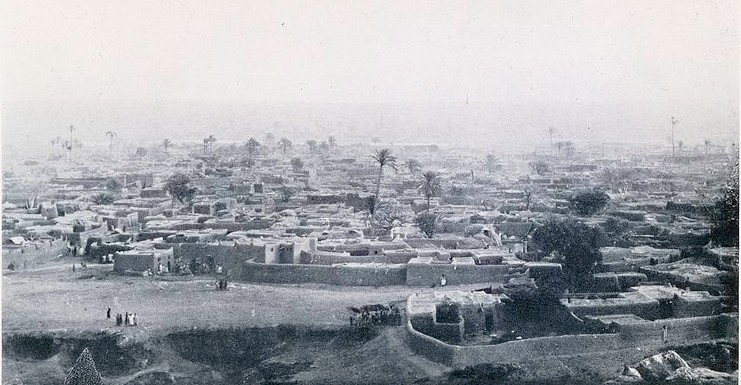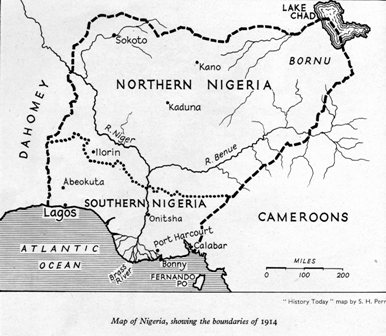ALBUM – view my Northern Nigeria Protectorate album
TRANSITION CHART for the British Nigeria area
Fast Facts
Region: West Africa
Group: British Nigeria
Classification: Colony (Britain)
Prior Regime: Royal Niger Company, Niger Coast Protectorate
Key Dates:
1900, Jan 1 – Northern Nigeria created by assuming territory from the Royal Niger Company
1902 – Capital of Northern Nigeria established in Zungeru
1914, Jan 1 – Southern Nigeria and Northern Nigeria were combined to form the colony of Nigeria
Following Regime: Nigeria Colony
Scott Catalogue: (Northern Nigeria) #1-52
Pick Catalogue: none
History

British influence in the Nigeria area increased gradually over the 19th century, but they did not effectively occupy the area until 1885, when competitive pressure increased from France and Germany. The Royal Niger Company was formed in 1879 as the United African Company; renamed to National African Company in 1881 and to Royal Niger Company in 1886. It was chartered by the British government to develop the Niger basin.
As the Germans began to flex their colonial muscles by annexing Togoland and Cameroon, the British and the French realized that decisive action was required before they started losing their territory. At the Berlin Conference (1885), the major European powers carved up Africa for colonization, thus, with the exception of Ethiopia and Liberia, all of Africa was to be ruled by the Europeans.
 As development proceeded in Nigeria, it soon became obvious that the practice of managing territories through chartered companies could no longer compete with the Government run colonies of the French or Germans. Therefore, the Britain canceled the charter for the Royal Niger Company for the sum of £865,000 and rights to half the mining revenue for 99 years. On 1 Jan 1900, the territories of the Niger basin were transferred to the British government and the Protectorates of Northern Nigeria and Southern Nigeria was formed.
As development proceeded in Nigeria, it soon became obvious that the practice of managing territories through chartered companies could no longer compete with the Government run colonies of the French or Germans. Therefore, the Britain canceled the charter for the Royal Niger Company for the sum of £865,000 and rights to half the mining revenue for 99 years. On 1 Jan 1900, the territories of the Niger basin were transferred to the British government and the Protectorates of Northern Nigeria and Southern Nigeria was formed.
Northern Nigeria was still quite remote, so the British essentially had to fight to assume their “rights” to colonize the region. Sir Frederick John Dealtry Lugard was appointed the first High Commissioner of the newly created Northern Nigeria Protectorate and in 1902 he established Zungeru as the headquarters for the protectorate because it was the most northerly city accessible by river transport. Soon afterwards, the British military begin taking the region. The remnants of the Bornu Empire were conquered in 1902, the Sokoto Caliphate and the Kano Emirate were taken over in 1903 and fighting continued in 1904 in Bassa. In 1906 a large Mahdist revolution began outside of the city of Sokoto in the village of Satiru and a combined force of the British and the British-appointed Sultan of Sokoto, Muhammadu Attahiru II, destroyed the town and killed most residents involved. By 1907 most of the rebellions were quelled and the use of military force was less necessary as the focus turned toward taxation and administration.
Northern Nigeria Protectorate was ruled by including the chiefs and emirs as “native authorities” fitting into British administration. Regardless, every attempt at taxation were resisted by the emirates and the very powerful merchant class thus the Protectorate was never able to be run profitably. In 1914, Northern Nigeria and Southern Nigeria was joined to form the single colony of Nigeria. The unification was done for mostly for economic reasons rather than political, as Northern Nigeria Protectorate had a budget deficit; and the colonial administration sought to use the budget surpluses in Southern Nigeria to offset this deficit.
Stamps
 ALBUM
ALBUM
The first postage stamps were issued for Northern Nigeria Protectorate beginning in March 1890. All stamps of the Protectorate were definitive issues using a Key Plate design, differing only by Queen or Kings portrait, the type of paper, watermark, or color.
The first series consisted of nine stamps with values ranging from 1/2 pence to 10 shillings, depicting Queen Victoria. The second series, issued on 1 Jul 1902 consisting of the same denominations depicting King Edward VII. A £25 stamp was issued in April 1904 which, although was available for postage, was really intended as a revenue stamp. It was used to pay for imported liquor licenses, and is extremely rare. In 1905, the King Edward series was reissued in eight denominations, and again in 1910-11 in eleven denominations.
The final series of stamps was issued in 1912 which was a series of thirteen denominations depicting King George V.
Northern Nigeria stamps were replaced by stamps of Nigeria Colony in 1914.
Banknotes
British Currency was used in Northern Nigeria
Links
Northern Nigeria History from BritishEmpire.co.uk
Northern Nigeria Protectorate from Wikipedia
The Fall of Kano from History Today
Stamps of Colonial Nigeria from Stamp Collecting Blog




